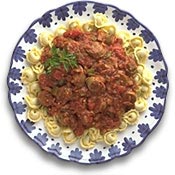|
|
Cuisine Glossary
| You have reached our International Cuisines and information on all aspects of a countries cuisine.
We will try to explain the culture, significant influences, climate, and other factors that have come together to create a distinct style. For example: Spanish, Mexican or Japanese. |
Italian: Tuscany Cuisine
 |
Tuscany: Florence, Sienna, Pisa, Livorno, Arezzo, FiesoleJust as Dante executed a kind of coup...claiming de facto by his masterpiece the Commedia, that the local Florentine dialect was henceforth to be known as THE Italian vernacular...so Florentine cooking, especially that of the early Renaissance, has become the resonant voice of Italian food in European history. Great Florentine cooking blossomed, appropriately, in the same cultural garden as did Giotto, Boccaccio, and Petrarch. In fact, Florentine feasts were major cultural happenings -- various courses were interspersed with performances by actors, dancers, or musicians. The table provided an occasion for visual artists to create elaborately wrought sculptures and dioramas out of butter, sugar, ice, and even napkins (which sometimes were folded so as to release a live bird or other creature when unfolded by the guest). Despite the over-the-top performances of the feast, the Florentine Renaissance, especially as it occurred in the kitchen, became a puritan-esque rejection of excess and rich sauces. Recipes glorified the simple goodness of the ingredients. Sauces were light if present at all. Even in the Medici palaces, herbs and oils displaced butter and cream. Celebration of pure, simple goodness is an easy task for Florentines, who live in the Eden-like bounty of Tuscany. Game is abundant, and seafood always near. Tuscany`s famous white Chianina cattle are butchered into steaks which are grilled and served rare and unadorned save perhaps for a squeeze of lemon (Bistecca or Costata alla Fiorentina). These cows produce little milk, and Tuscany therefore uses more olive oil than butter, and has no distinctive cheese-making tradition. Olive oil from this region is among Italy`s best. Italian olive-o-philes are as fanatical and exacting as French oenophiles. Chianti is a regional wine and is the perfect mate for nearly all her foods. Tomatoes, potatoes, and white beans, all originally imported from the Americas have become seamlessly integrated into the cuisine. Rosemary, sage, basil, and parsley are the main cooking herbs; nutmeg and black pepper the most common spices. Other raw ingredients, which mark the local fare, are artichokes, melon, pumpkins, chestnuts (an ancient ingredient used to make flour for cakes, sauces, etc.), mushrooms, spinach (which is, of course, the trademark ingredient in anything cooked Florentine). The Tuscan cook loves to roast meats over an open fire, to cook a great pot of soup, and to coax the best out of her raw ingredients. Source: HungryMonster Writers |




